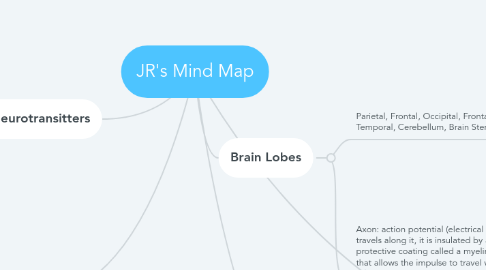JR's Mind Map
저자: Jessica Hamilton Davey


1. Neurotransitters
1.1. Examples: dopamine, seratonin, GABA, acetylcholine, etc.
1.2. Function: inhibit or excite some kind of response when released. Allow communication between cells almost instantaneously.
2. The Nervous System
2.1. Function: transmission of signals throughout the body, connects the brain and spinal cord to muscles, and sensory receptors on the skin to allow for movement and sensations.
2.2. Organs/structures involved: brain, spinal cord, neurons, glial cells.
2.3. (Central Nervous System) CNS:the brain and spinal cord
2.4. Peripheral Nervous System (PNS): all the nerves, neurons and supporting neural cells that are located outside of the brain and spinal cord.
3. Cell body: contains the nucleus of the cell, aka the DNA/ organelles, etc.
4. Brain Lobes
4.1. Parietal, Frontal, Occipital, Frontal, Temporal, Cerebellum, Brain Stem
4.1.1. Parietal: sensory processing center, language, and mathamatics.
4.1.2. Cerebellum: voluntary movements, balance, coordination, relays information from the brain stem to the cortex and vice versa.
4.1.2.1. Frontal: cognitive skills, emotional expression, judgement, "higher thinking"
4.1.3. Temporal: auditory processing center
4.1.4. Occipital: primary vision processing center
4.1.5. Brain Stem: involuntary procesess, swallowing, breathing, heart beating etc.
